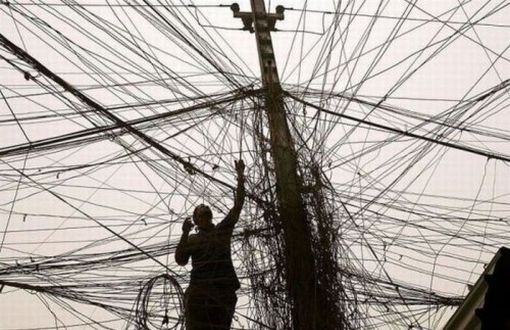Click to read the article in Turkish
The Parliamentary Bill about Change in Electricity Markey Law was submitted to the Turkish Grand National Assembly (TBMM) last week in a rush, and was accepted in the General Assembly. The new law draft, promoting local coal based production caused intense debates between all parties including producers, distribution companies and environmentalist. Public concern is about who will bare the costs of loss and illegally used electricity.
In 2012 a consumer applied to the consumer rights arbitration tribunal when the loss and illegally used electricity cost was reflected on his bill, and a long trail process started. The process reached until Supreme Court Assembly of Civil Chambers, and at the end, the decision was that it was not a fair practice to reflect the cost of loss and illegally used electricity on the bill of a consumer which must only state the amount of electric purchased.
What is Loss and Illegal Use Cost?
Loss and illegal amount is equal to the difference between the amount of energy entering the distribution system and the amount distributed to the consumers. The cost of this amount is determined with the aim to compensate for the technical and non-technical loss in the distribution and illegally used electricity’s rate in terms of loss and illegally used costs. Besides the amount lost in distribution and transmission, the consumption of electricity with deficient and wrong measurement to prohibit determining the correct consumption amount in illegal usage and/or non-measurement is included in this item.
To minimize the loss and illegal use in electricity specific time periods and targets are identified. The institution which identifies and is responsible for the realization of these targets is, Energy Market Regulatory Authority (EMRA or the institution). I will elaborate on these targets and how the institution’s history of incapability of realizing them in below.
Collection the cost of the Loss and Illegal Use in Electricity is not fair
According to the current 6446 Numbered Electricity Market Law, the pricing fare is published by EMRA. Annunciations are made according to the Retail Pricing Regulation. Distribution companies bill the consumers parallel to these annunciations. The law states that the tariffs approved by the Board will not comprise costs that are not directly related to market operations, therefore it’s arranged that the consumer will pay according to the amount they used.
This regulation is explained by its ability to free the market, protect the consumers and transparency. Then, should the TRT share (State TV channel contribution), energy fund and loss/illegal use cost on the bills be considered as market operations? If these are market operations, why would the consumer be liable to pay? What is the legal justification of this item in the bill that the consumer didn’t agree to pay in a contractual commerce relation that the new market conditions are offering? Moreover, how is the fact that the cost of loss and illegal use is now, not identified on the bill as a separate item but included in the “distribution cost” item, agrees with the transparency principle?
Supreme Court decided that it is against the principle of the state of law and unfair to collect the cost of the loss and illegal use of electricity from consumers who obey to the rules. The decision underscores that EMRA is responsible for the pricing operations in the electricity market. Despite this, the institution is not authorized to identify unlimited pricing items. The decision of the Supreme Court states that it is against the law that the distribution companies are making consumers pay for the loss and illegal use costs.
Supreme Court debated the loss/illegal use cost within the context of the Law on the Protection of The Consumer; and underscored the fact that this cost –except for one item that the administration determines depending on one-sided public force-, is a result of the contractual relationship between the consumer buying the electricity and retail distribution company. This is why in the context of protection of the consumer, all the costs included in the bills, which were not negotiated with the consumer and which causes imbalance against the consumer by being contrary to the obligations for honesty of the parties arose from the contact, should be considered as unfair terms.
The reflection of the cost of loss/illegal use in the bills is again on the table with a law amendment despite Assembly of Civil Chambers’ decision. No doubt that the objective is to create a “legal guarantee” to bill the cost of loss/illegally used electricity to consumers. Likewise, 2% TRT share item on the bill was subject to a similar legal debate, and the Conseil D’etat previously decided that it was not against the positive law to make consumers pay for TRT share because it was a legal liability.
It is very important to point out to the justification of the decision of Supreme Court Civil Chambers about loss/illegal cost collection in terms of concepts of “state of law” and “justice” and “protection of the consumer (end user)”. This injustice is not only against the legislation, but is also against the law in terms of the constitution. This means that the recent amendment of law should be considered as unconstitutional since it gives a right to EMRA that it cannot have constitutionally.
Let’s look at the electricity market in close without being too detached from the loss/illegal use issue while the motivations for being against this practice that “cost a bomb” is fresh among public opinion.
New Regulations in Electricity and Loss/Illegal Use
In 2013, 6446 Numbered Law went in effect and a major change in electricity market occurred. The private sector was appointed to ensure supply safety, which now became a legitimizing discourse for adverse effects on human health and environmental destruction. Preparing the market to be suitable for investment for the private sector and to make the market attractive became overall politics.
This open market perspective brought with it a free consumer concept. While supply was all open for competition, concerning transmission and distribution –despite distribution was privatized, the public remained as a major actor. Therefore, the cost of investments to ameliorate the distribution system is on the shoulders of the public, and the canalization of distribution operations, tracking and inspection is included in the responsibilities of the institution.
With the market becoming open, the buying and selling of electricity became a contractual relationship between retail companies and consumers. Even the way for bilateral agreements between suppliers and consumers was cleared (sui generis agreements). This situation brought the electricity market into consumer law’s concern.
Finally, as stated in the Supreme Court’s decision the selling of electricity in open market conditions and in a contractual relationship is related to the protection of consumer rights. However, are these open market conditions offer the information on the resources of the electricity that is sold to the consumers whom it subjects to a contractual relationship with the companies? What are the limits of consumers in choosing the supplier? To what extent consumers’ rights coming from consumer law and code of obligations are protected against the companies and EMRA? To keep it short, the market is open according to whom or what?
Even though this open market is trying to make positive discrimination for renewable energy with feed in tariff like opportunities, so called contribution payment, charged by the state for renewable energy and the attraction made for other type’s energy production makes renewable energy weak in competing with all the other forms of energy production.
Loss/Illegal Use of Electricity and Centralist Policies
If we turn back to the issue of loss/illegal use of electricity, we must first identify this: the energy policies of Turkey is depending on producing electricity in large facilities in the East on consumption in the West. The result of this electricity policy of not producing and consuming in the same region is technical losses in transmission from producing companies to distribution companies. No doubt that a centralist energy policy is a wider issue in energy democracy, but I am just trying to point out to the loss and illegal use here.
Loss/Illegal use Targets are Unsuccessful
There are different electricity distribution zones around the country. These distribution companies and Turkish Electricity Distribution Corporation (TEDAŞ) periodically determine targets limits to decrease the loss and illegal use rates. The responsible institutions in reaching these targets are EMRA and TEDAŞ. These two institutions are liable for identifying loss and illegal use rates, necessary work to reach the targets, and controls.
When we look at success in realizing the target, it does not look successful. In years 2011-2015 the targets were not reached and plus there were severe deviations. In 2011, TEDAŞ couldn’t realize the 15% loss/illegal use rate and the rate was 18%, in 2012 the average loss/illegal use target rate for Turkey was 13.5% but was 18% in reality. In 2013, even though they revised the target, they still could not realize it and the rate remained 18%.
EMRA’s targets in 2015-2019 action plan is even more ambitious. According to the action plan, it is targeted that the rate decrease to 10% by 2019, with a 1% decrease every year starting from 2015. However, there is no information in the plan on the investments to be made to realize this target.
Loss and illegal use is not only Turkey’s problem but if we make a comparison with Europe and the USA, the situation is very severe in Turkey. The rate in the Netherlands and Germany was 4%, the average rate in Europe was around 5-6% and 6% in the USA, in 2015.
Instead of a Conclusion
The amendment of law from last week makes the collection of the cost of loss and illegal use of electricity incompatible with the principles of the state of law and justice. This legal guarantee to make it possible to reflect the cost of loss and illegal use of electricity to the bills of the consumers is only another type of unlawful amendment. By this way, an institution which was unable to realize its targets ever, practices that are not audited carefully or even not audited at all and which are anti-transparent, and the cost of loss and illegal use of electricity item on the bills will continue to stay.
We will see if the decision of the Supreme Court Assembly of Civil Chambers that the practice was contrary to state of law and justice itself, will be evaluated concerning the Constitutional Court when the article is brought to the constitutional court.
“I can make my way behind the higher judicial decisions, I can shape the market according to my own needs, I can delay environmental investments as long as I can” type of electricity policy is not only a concern for environment, justice and democracy but at the same time it clearly represent deviance in transparency, good management and unfair competition.
If you carefully look at your electricity bill, which is an output of this system, you will see that not only the loss and illegal use of electricity is in your door now but air pollution, climate change, environment destruction, early deaths, and the injustice and unlawfulness concerning electricity production and distribution are inside your house too. In a country where environment, human health, climate, justice are no longer important and violating them are considered as normal, the relationship between your electricity bill and the cost of loss and illegal use of electricity can help make new connections. (DB/HK)





